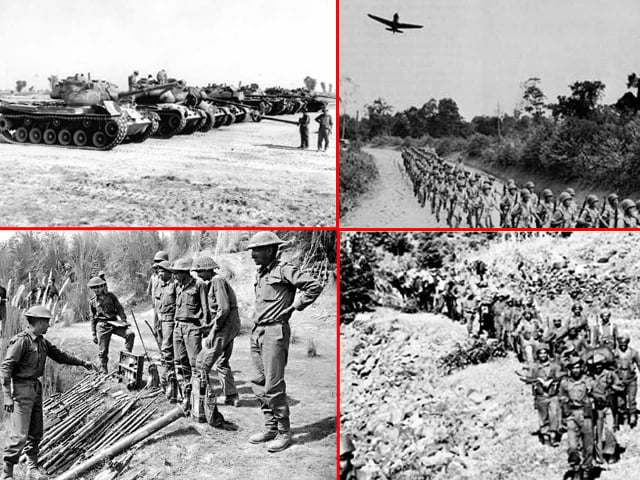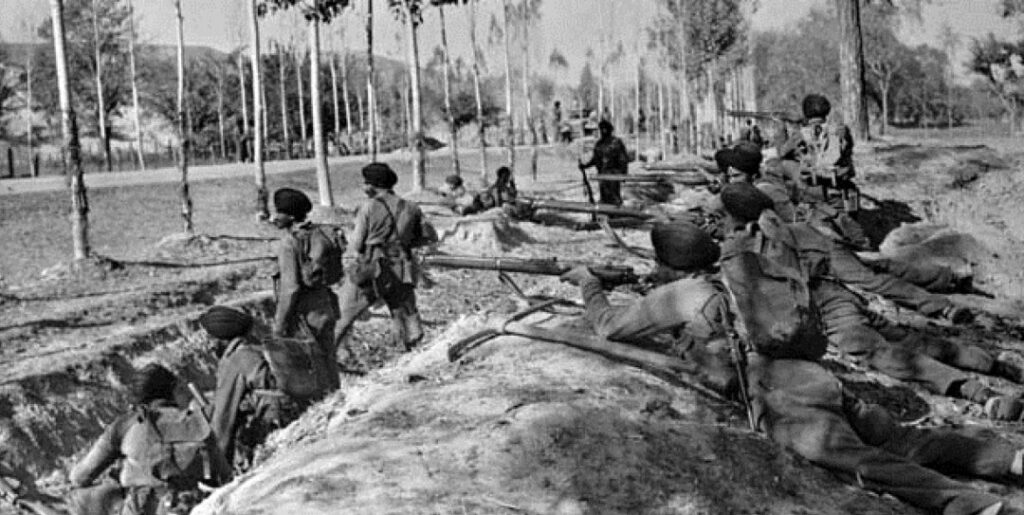1947 – 1948: First India-Pakistan War

The first Indo-Pakistani war, also known as the Kashmir war, was fought between the newly independent nations India and Pakistan between 1947-1948 over the princely state of Jammu and Kashmir. It was the first of four Indo-Pakistani wars between the two newly independent nations. The bone of contention between India and Pakistan were the attempts by Pakistan to annex the erstwhile state of Jammu and Kashmir by any means. Hence, the war of 1948 can be termed as a war of liberation because the conflict stemmed from the struggle for independence, with both India and Pakistan vying for control over Kashmir.

This essay attempts to analyse the first Indo-Pakistan war of 1948 by discussing the type of conflict that struck the two newly independent nations, the legitimacy of the war, the geopolitical and historical context of the war, the outcome and a prognosis of its relevance in the contemporary era.
Before 1947, Jammu and Kashmir was a princely state. Its ruler, Maharaja Hari Singh did not want to merge with either India or Pakistan but wanted to have an independent status for his state. This sentiment was popular in Kashmir because they did not see themselves as Pakistanis or Indians but as Kashmiris above all. This issue of regional aspiration is known as Kashmiriyat. In October 1947, Pakistan sent tribal infiltrators from its side to capture Kashmir. Due to the crisis that erupted in Jammu and Kashmir, Maharaja Hari Singh was bewildered. While the Government of India was keeping a close watch on the developments in the state. It was only on 24 October 1947; the Government of India received the first news of the invasion of Kashmir. Then on the same night at 1100 Hours an urgent request was received from Maharaja Hari Singh, specifically requesting Indian Government to send Indian troops to Kashmir to protect it from the invaders. The Defence Committee of the Cabinet discussed the situation and the urgent pleas of the state of Kashmir and popular leader Sheikh Abdullah for military assistance to halt the raiders in Kashmir. After several rounds of discussions, it was decided that Indian troops would be sent to Kashmir only after formal accession to India.
VP Menon (Secretary, Ministry of States, Government of India) flew to Jammu in the afternoon of 25 October 1947, and brought back Instrument of Accession, signed by Maharaja Hari Singh. With the acceptance of this legal document by the Governor-General of India on the evening of 26 October 1947, the state of Jammu and Kashmir became an integral part of India dominion, legally, morally and constitutionally. Once the state of Jammu and Kashmir had acceded to India, Pakistan as a friendly neighbour should have accepted the decision and stopped the invading forces. However, a desperate Pakistan continued to provide the invaders with all possible help. India argues that the accession of Kashmir to its territory was legitimate under the terms of the India Independence Act of 1947, which provided for the accession of princely states based on the wish of their rulers. Furthermore, India maintains that the Instrument of Accession signed by Maharaja Hari Singh was valid and legally binding. On the other hand, Pakistan disputes the legitimacy of Kashmir’s accession to India, arguing that it was coerced and not representative of the will of the Kashmiri people.

Pakistan claims that the majority Muslim population of Kashmir would have chosen to accede to Pakistan if given the opportunity through plebiscite. The reason why the two countries have been adamantly claiming the influence over Kashmir is its geopolitically strategic location. In 1947, on the map of India, the state of Jammu and Kashmir appeared as a somewhat rectangular projection in the extreme North-West corner of the sub-continent. In size it was the largest of the Indian ‘Princely States’ during the pre-independence era. It was 222,870 sq. km or roughly double the area of Demark, the Netherlands, Belgium and Luxemburg combined. To the East lay Tibet; to its North lies Chinese Turkestan or Sinkiang (Xinjiang); to West is Afghanistan; to South-West and South was Pakistan; and to the South and South-East lay the states of Punjab and Himachal Pradesh of India. Wakhan corridor, a narrow strip of territory in Afghanistan, extending to China and separating Tajikistan from Gilgit-Baltistan lies to the North West. Kashmir’s geopolitical location at the crossroads of South Asia, Central Asia, and the Middle East, coupled with its unresolved status and rich natural resources, make it a focal point of regional geopolitics and a source of contention between India and Pakistan. Politically, in the context of the 1948 India-Pakistan war over Kashmir, both India and Pakistan were led by leaders who played significant roles in galvanizing support for the conflict. On the Indian side, Jawaharlal Nehru, the first Prime Minister of independent India, played a crucial role.
(Read more: India’s Border Security Challenge: Rogue Drones and Smuggling Surge)
Nehru was committed to preserving the secular and democratic ideals of the newly independent nation. He saw the integration of Kashmir as essential for maintaining the territorial integrity of India and upholding the principles of democracy and secularism. Nehru’s leadership style was characterized by a strong adherence to diplomatic efforts, but he also understood the necessity of military action to defend India’s interests in Kashmir. In Pakistan, Muhammad Ali Jinnah, the founder and first Governor-General, played a pivotal role in advocating for the rights of Muslims in South Asia and the creation of Pakistan. Jinnah saw the accession of Kashmir to Pakistan as vital for the country’s security and the fulfilment of the vision of a separate Muslim homeland. He supported the mobilization of tribal militias and Pakistani military forces to seize control of Kashmir, viewing it as a legitimate response to what he perceived as the oppression of Muslims in the region. The hawkish and revolutionary leadership on both sides, coupled with the triggering event of the invasion of Kashmir, played instrumental roles in galvanizing support for the 1948 India-Pakistan war. The peace following the 1948 war has indeed been fragile, with periodic escalations of tensions between India and Pakistan over Kashmir.
(Read More: International Yoga Day Celebrated at Indo-Pak Border in Gujarat)
Despite various ceasefire agreements and confidence-building measures, such as the Lahore Declaration of 1999 and the ceasefire agreement of 2003, violence along the Line of Control (LoC) and in the Kashmir Valley continues to erupt sporadically. Incidents such as cross-border shelling, militant attacks, and protests often escalate tensions, highlighting the precarious nature of the peace in the region. The intervention of the UN in peacebuilding has not contributed significantly either. It played a role in mediating the conflict, particularly through its resolutions calling for a plebiscite to determine the future status of Kashmir. However, a lasting peace accord has remained elusive primarily due to the inability of India and Pakistan to agree on the modalities of a plebiscite and the preconditions for its implementation. While peace becomes important in the region, there is also the risk of conflict recurrence due to unresolved territorial disputes and historical animosities between India and Pakistan. The disputed status of Kashmir, coupled with competing nationalist narratives and security concerns, creates a volatile environment prone to sudden escalations.
Both countries maintain large military forces along the border, and any provocation or miscalculation could potentially lead to a renewed conflict, as seen in previous crises such as the Kargil War of 1999 and the Pulwama attack in 2019. Despite the challenges, expectations for the coming years include continued diplomatic efforts to resolve the Kashmir issue and mitigate tensions between India and Pakistan. International pressure, bilateral dialogues, and Track II diplomacy initiatives may offer avenues for progress. However, the path to lasting peace remains challenging, requiring political will, compromise, and sustained engagement from all stakeholders.
Conclusion
In conclusion, the 1948 India-Pakistan war over Kashmir was a pivotal event that shaped the geopolitical landscape of South Asia and continues to influence regional dynamics to this day. The conflict, rooted in the struggle for decolonization, territorial sovereignty, and the rights of Kashmiri people, was marked by hawkish leadership on both sides, with Jawaharlal Nehru and Muhammad Ali Jinnah playing instrumental roles in galvanizing support for military action. The legitimacy of the war remains contentious, with India and Pakistan presenting conflicting narratives regarding the accession of Kashmir to their respective territories. The unresolved status of Kashmir has led to recurrent tensions and sporadic violence between the two nations, contributing to regional instability and hindering efforts for lasting peace. The geopolitical significance of Kashmir, as a strategic border region with rich natural resources, further complicates efforts to resolve the conflict. Looking ahead, the prognosis for peace in Kashmir remains uncertain. While diplomatic initiatives and confidence-building measures may offer hope for de-escalation, deep-rooted historical grievances and territorial disputes continue to pose significant challenges. Ultimately, achieving lasting peace in Kashmir will require genuine dialogue, compromise, and a commitment to addressing the underlying issues that fuel conflict between India and Pakistan.


Leave a Reply